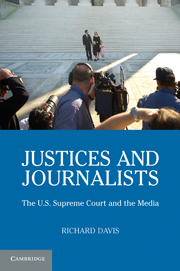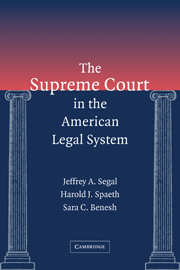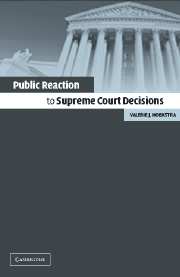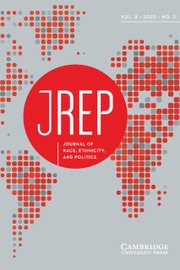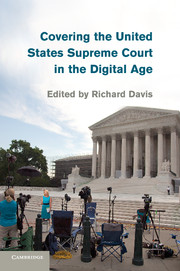Justices and Journalists
The U.S. Supreme Court and the Media
£25.99
- Author: Richard Davis, Brigham Young University, Utah
- Date Published: April 2011
- availability: Available
- format: Paperback
- isbn: 9780521704663
£
25.99
Paperback
Other available formats:
Hardback, eBook
Looking for an inspection copy?
This title is not currently available on inspection
-
Justices and Journalists examines whether justices are becoming more publicity-conscious and why that might be happening. The book discusses the motives of justices 'going public' and details their recent increased number of television and print interviews and amount of press coverage of their speeches. The book describes the interactions justices have with the journalists who cover them. These interactions typically are not discussed publicly by justices or journalists. The book explains why justices care about press and public relations, how they employ external strategies to affect press portrayals of themselves and their institution, and how and why journalists participate in that interaction. Drawing on the papers of Supreme Court justices in the nineteenth and twentieth centuries, the book examines these interactions over the history of the Court. It includes a content analysis of print and broadcast media coverage of Supreme Court justices covering a 40-year period from 1968 to 2007.
Read more- This is the only book to examine Supreme Court justices' incentives for engaging in press relations as part of a larger external strategic approach to the press and the public
- Offers many historical and current examples of justices' seeking to influence the press drawn from the papers of former justices
- Includes a content analysis of New York Times and NBC Nightly News coverage of Supreme Court justices over a critical time period in Court history, 1968–2007
Reviews & endorsements
'Supreme Court justices like to cultivate an image of being aloof and apart from politics and the media. Richard Davis' eye-opening book offers ample proof that to varying degrees, justices have engaged with journalists and politicians throughout American history. The Court's lofty mystique will never be the same.' Tony Mauro, Supreme Court correspondent for The National Law Journal, has covered the Supreme Court for more than 30 years
See more reviews'With the Justices now regularly writing books, publicly debating constitutional issues, and sitting for media interviews, Justices and Journalists could not be more timely. It's a path-breaking study that will generate discussion, debate, and research over the questions of how and why Justices 'go public' - and whether they should in the first place.' Lee Epstein, Henry Wade Rogers Professor, Northwestern University
'While 'going public' has rarely been seen as a strategic option for Supreme Court justices wishing to reveal themselves, in Justices and Journalists Richard Davis explains the increasing willingness of contemporary justices to do just that. In his fascinating account, Davis combines historical study with empirical analysis to reveal the panoply of motivations, personal, political and institutional, that have altered significantly judicial norms into the 21st century. This is rich scholarly work that will plant the seeds for continuing research while offering countless examples ripe for our classrooms. By focusing largely on the justices themselves, Davis leaves the reader with a better understanding of the seeming irony that, as most studies of media coverage of the Supreme Court have revealed, while coverage of the Court, per se, continues to dissipate, the justices, themselves, continue to be more newsworthy.' Elliott Slotnick, Ohio State University
'Davis gives us a look into how the justices' use of the press has changed. In a way, the curtain is pulled, removing the Court's mystique and anonymity. His research makes a valuable contribution to our understanding of the relationship between the justices and the press. This book is appropriate for journalists, lawyers, historians, and scholars and graduate students in mass communications, the judicial process, and political science.' Terri L. Towner, Oakland University
'… many of the chapters include useful sections relating to the often-thorny issue of cameras and digital technology in courtrooms, and taken together these chapters offer an unusually broad snapshot of how those practices have developed in a wide range of jurisdictions.' Richard Jones, Entertainment Law Review
Customer reviews
Not yet reviewed
Be the first to review
Review was not posted due to profanity
×Product details
- Date Published: April 2011
- format: Paperback
- isbn: 9780521704663
- length: 264 pages
- dimensions: 228 x 152 x 15 mm
- weight: 0.36kg
- contains: 8 tables
- availability: Available
Table of Contents
1. External strategies
2. The pressure to go public
3. The early years
4. The nineteenth century
5. The twentieth century
6. Becoming newsworthy
7. The twenty-first century.
Sorry, this resource is locked
Please register or sign in to request access. If you are having problems accessing these resources please email [email protected]
Register Sign in» Proceed
You are now leaving the Cambridge University Press website. Your eBook purchase and download will be completed by our partner www.ebooks.com. Please see the permission section of the www.ebooks.com catalogue page for details of the print & copy limits on our eBooks.
Continue ×Are you sure you want to delete your account?
This cannot be undone.
Thank you for your feedback which will help us improve our service.
If you requested a response, we will make sure to get back to you shortly.
×
